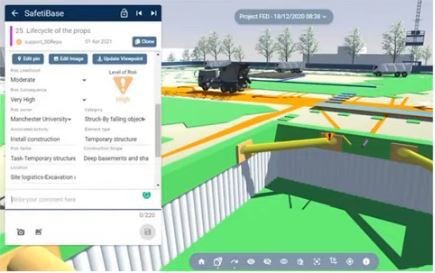
AstraZeneca is set to test wearable BIM-linked safety sensors to enhance safety zones on its Macclesfield Campus project.
AstraZeneca is conducting the test in partnership with the Lloyd’s Register Foundation’s Discovering Safety initiative (delivered by the Health & Safety Executive). The test team hope that adding the wearable BIM-linked sensors from start-up Plinx to people and physical barriers will improve zonal procedure accuracy and help to manage out risk to workers before harm can occur.
The team will first plan out the safety zones on the digital model, informing how the zones can be demarcated on site using the sensors. They will then monitor the zones using the BIM interface. They will use the monitoring information to improve week-on-week management of the safety zones, and to feed back information to planners and designers about how effective these preventive measures are.
The BIM model uses Asite 3D Repo’s established SafetiBase software. According to the project team, the use of sensors on site linked to local networks is not new. However, the ability to link and view feedback information directly on a construction design 3D/4D model interface has not been demonstrated before.
Jozef Dobos, of Asite 3D Repo, said: “For a number of years, our customers have been able to virtually identify health and safety risks within the 3D BIM environment using SafetiBase. But we wanted to provide more feedback from the construction sites too. In this project, for the first time, we are linking the virtual with the physical, thanks to the integration of Plinx’s wearable IoT sensors, which is really exciting.”
Foreseeing on-site hazards
Plinx founder and chief executive Tommy Williams is responsible for the site-based deployment of the sensors to demarcate safety zones. He explained: “This project builds upon Plinx’s work in the Industrial Safetytech Regulatory Sandbox project: connecting sensors and 4D models to empower stakeholders in foreseeing on-site hazards, using safety zones for protection and informing improved future implementation. This first-of-a-kind solution will demonstrate how to connect commercially available technologies in order to drive improved safety performance.”
Dave Ayres, construction lead at AstraZeneca, said: “Learning from our last innovative project in Discovering Safety, the benefits from a client perspective were sometimes surprising. The 3D modelling was particularly useful for our end-user team who were able to make some fundamental changes to the design long before they had any impact on the schedule.”
Brian Street, part of the AstraZeneca team, added: “The need to engage designers and contractors early to develop the 3D model and to plan the safety zones, reinforces the strengths of collaborative working and has many other spin-off benefits.”
EDF Group subsidiary Dalkia is the main contractor building the extension to the campus. A spokesperson said: “The integration of real-time feedback from such a diverse sensor network into a BIM model signifies more than just an advancement in technology: it represents a forward leap in creating smarter, safer, and more responsive construction environments. Our hope is that this initiative will pave the way for a more proactive, data-driven approach to safety, setting a new standard for the entire industry.”
Expected outputs
The team expects the test outputs will:
- demonstrate the feasibility of monitoring both successful and unsuccessful performance of a safety zone on a construction site during the construction phase;
- demonstrate how high-quality information from the sensors on site can be visualised and analysed using a 3D model via a playback scenario, in order to inform future decisions of site planners and designers;
- provide a foundation for generating guidance and best practice for the industry;
- contribute to HSE knowledge about effectiveness of digital tools in construction; and
- contribute to health, safety and productivity by reducing waste and loss in construction.
Don’t miss out on BIM and digital construction news: sign up to receive the BIMplus newsletter.












